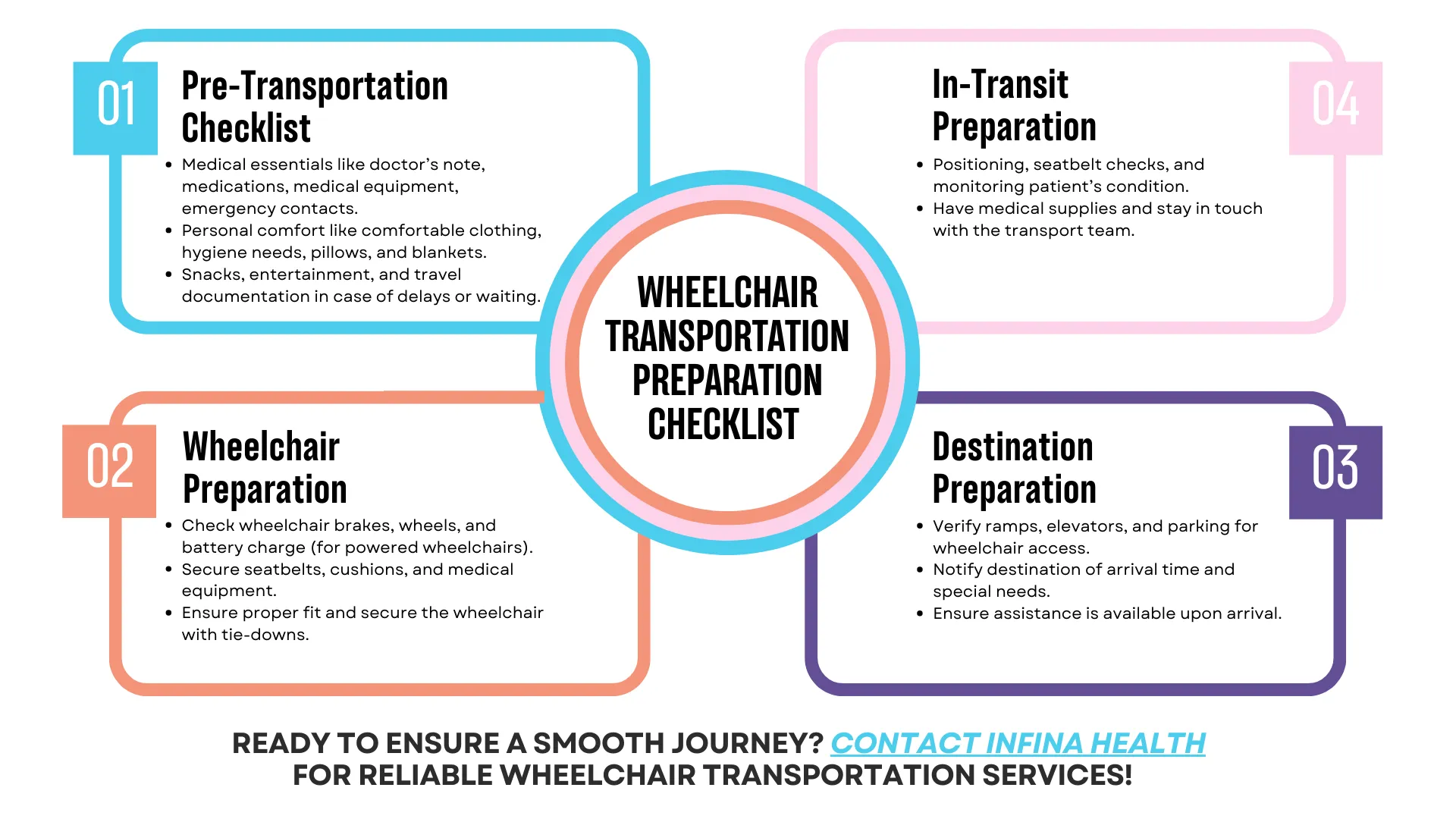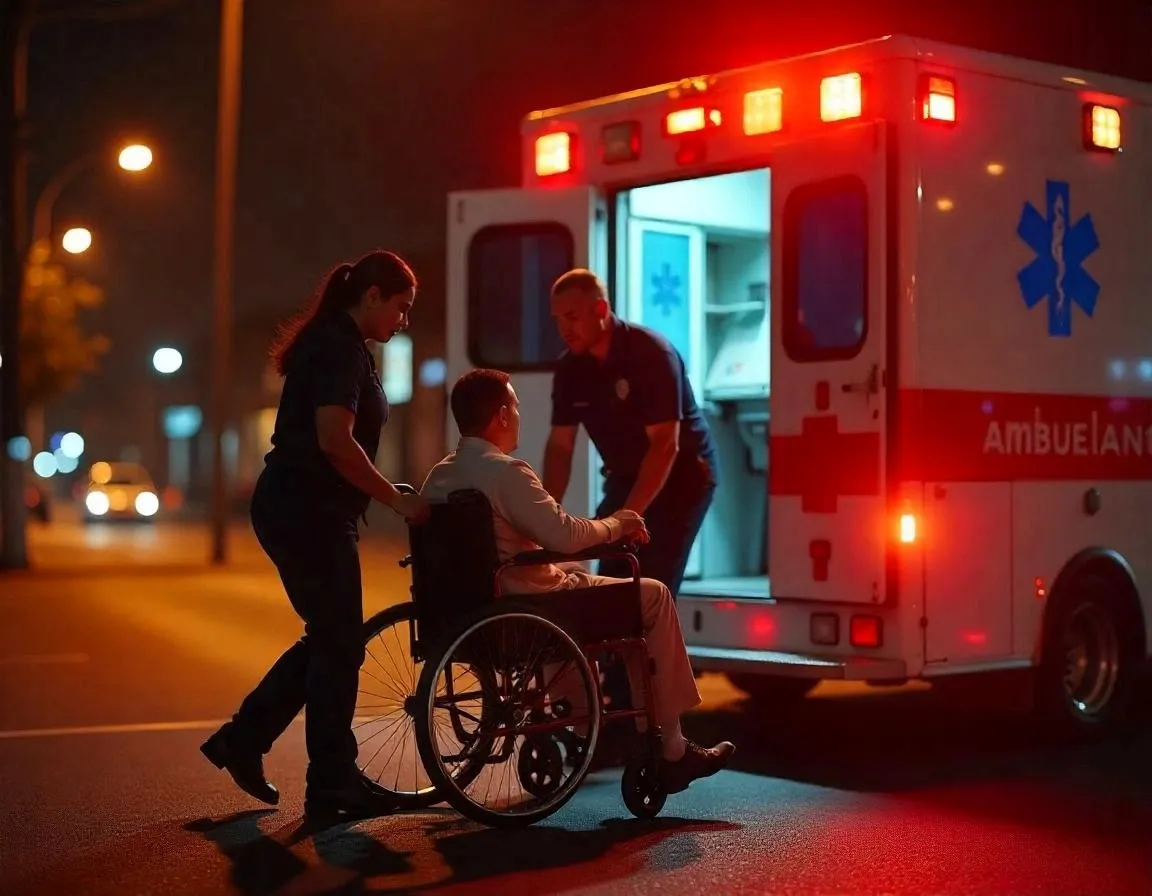Publish Date: May 23, 2025
A Patient’s Checklist for Wheelchair Transportation Preparation
In recent years, medical transportation for individuals with disabilities, particularly wheelchair users, has become an increasingly essential service. As the number of people with mobility impairments continues to rise, the need for safe and efficient transportation solutions is more pressing than ever. An estimated 5.5 million Americans use a wheelchair, and this number is likely to increase in the coming years. That said, wheelchair users often face unique challenges when traveling, from navigating public transportation to accessing healthcare facilities. Proper preparation for wheelchair transportation is vital to ensure a comfortable, secure, and stress-free journey.
Proper preparation allows caregivers, family members, or medical professionals to handle any challenges that arise during transit, whether physical, medical, or logistical. Given the potential for discomfort or distress, a well-thought-out checklist is invaluable to ensure that patients receive the best care while traveling. This blog will outline a detailed checklist for patients who use wheelchairs, as well as for their caregivers and transport professionals. We will cover key aspects of preparation, including personal care, wheelchair readiness, safety measures, and tips for ensuring a smooth and stress-free journey. Whether you’re the patient or the caregiver, this guide will help you feel more confident and prepared.
Types of Wheelchair Transportation for Patients to Choose from
When planning wheelchair transportation, it is important to understand the various options available. Each type of transportation has its specific advantages and considerations:
1. Ambulance Transport
Ambulance transport is typically reserved for emergency situations or when a patient requires immediate medical attention. This mode of transportation offers the highest level of medical care and is equipped to handle critical situations. However, it’s important to note that ambulance services can be costly, and it’s generally recommended to use non-emergency transportation options whenever possible.
2. Non-Emergency Medical Transport (NEMT)
NEMT services provide scheduled transportation for non-emergency medical appointments, such as doctor visits, therapy sessions, or dialysis treatments. These services are often covered by insurance or government programs and are designed to be more affordable and less urgent than ambulance transport. NEMT providers can offer a variety of transportation options, including wheelchair-accessible vehicles and trained medical staff.
3. Private Vehicle/Family Transport
Many wheelchair users rely on family members or caregivers to transport them in their own vehicles. This option can be convenient and cost-effective, but it requires careful planning and preparation. It’s essential to ensure that the vehicle is accessible, equipped with a wheelchair ramp or lift, and properly secured for safe transportation.
4. Paratransit Services
Paratransit services are specialized transportation options for individuals with disabilities who cannot use regular public transportation due to mobility limitations. These services are typically door-to-door and are designed to accommodate individuals using wheelchairs or other mobility aids. Availability, eligibility, and scheduling vary by location, so it’s essential to check with your local paratransit service for specific requirements. Some systems may require advance notice or reservations to ensure accessibility.
5. Bariatric Wheelchair Transport
Bariatric wheelchair transport is designed specifically for individuals who require larger, more robust wheelchair accommodations due to size or weight. These services use specialized vehicles and wheelchairs that provide additional space, support, and comfort for bariatric passengers. Bariatric transport ensures safety during travel for individuals with greater mobility needs, offering a tailored solution for those who require extra capacity. Make sure to inquire about bariatric transport options when booking to ensure appropriate accommodations.

Pre-Wheelchair Transportation Checklist for the Patient
Preparing for wheelchair transport involves more than just ensuring the vehicle is accessible. It is also about ensuring that the patient’s medical and personal needs are met throughout the journey. The following checklist covers essential steps to help make the trip as comfortable and safe as possible:
1. Medical Documentation and Essentials
To ensure a safe and smooth journey, having the right medical documentation and supplies is essential.
- Doctor’s Note: It’s important to bring a doctor’s note or medical documentation that outlines the patient’s condition and any special needs for the trip. This could include details about their mobility limitations, allergies, and any conditions that transport personnel should be aware of.
- Medication: Always pack the necessary medications the patient may need during the transport, along with a list of prescriptions. Having this information available is crucial in case of an emergency or if a healthcare provider needs to be contacted.
- Medical Equipment: If the patient uses medical equipment (such as oxygen tanks, feeding tubes, or portable suction devices), make sure everything is in working order and ready for use. Check the battery levels, ensure you have extra supplies, and confirm that the equipment is easily accessible during transport.
- Emergency Contact Information: Keep a list of emergency contacts that includes caregivers, family members, and healthcare professionals. Ensure this list is easily accessible and provides the necessary information in case the transport staff or caregivers need to reach someone quickly.
2. Personal Care and Comfort
Ensuring the patient is comfortable and well-cared-for is key to a positive transportation experience.
- Clothing: Choose comfortable, easy-to-wear clothing that is appropriate for the weather. Layering is a good idea so that the patient can adjust to temperature changes during the journey. Avoid tight or restrictive clothing that may cause discomfort.
- Personal Hygiene: Take steps to ensure the patient’s hygiene needs are met before the journey begins. This includes changing any incontinent products, ensuring proper catheter care, and performing any other hygiene routines that are necessary. Fresh clothes and wipes can also help maintain cleanliness during the trip.
- Comfort Items: Pack items that will make the journey more comfortable for the patient, such as a supportive cushion, a warm blanket, or a soft pillow. These items can help prevent discomfort or pressure sores during long trips and provide emotional comfort.
3. Prepare for Potential Delays or Waiting
Transportation can often involve unexpected delays, so it’s important to be prepared for any waiting time along the way.
- Snacks and Hydration: Long trips, especially if they involve delays or extended waiting, can leave the patient feeling hungry or thirsty. Pack easy-to-eat snacks and water to keep the patient hydrated and energized. Non-perishable items like granola bars or dried fruit are ideal.
- Entertainment: To help pass the time and reduce stress, pack entertainment options for the patient. This could include books, a tablet, or a set of headphones for listening to music or watching movies. Distractions like these can help make the journey more pleasant.
- Travel Documentation: Keep all necessary documents organized and easily accessible. This includes appointment confirmations, transportation passes, insurance information, and any other paperwork required for the trip. Having everything in one place ensures that you won’t waste time searching for documents in case of an issue.

Two medical professionals helping a man with special needs into wheelchair transportation.
Ready to reserve your wheelchair transportation? Schedule a service for a hassle-free experience!
Book Now!
Preparing the Wheelchair for Transportation
The relevant authorities must make sure that the wheelchair is properly prepared for transportation. Below are the key steps to follow for effective preparation:
1. Check Wheelchair Functionality
Before setting out, make sure the wheelchair is in optimal working condition.
- Wheelchair Maintenance: It’s essential to inspect the wheelchair thoroughly before the trip. Check the brakes to ensure they engage and release properly and inspect the wheels for any wear or damage. A smooth and functioning wheelchair reduces the risk of accidents and discomfort during transport.
- Battery Charge (for powered wheelchairs): For powered wheelchairs or mobility scooters, verify that the battery is fully charged before the trip. A fully charged battery ensures the wheelchair functions without interruption during travel. If the journey will be long, consider bringing a spare charger or backup power source to avoid any disruptions.
- Cleanliness: Make sure the wheelchair is clean and hygienic before transport, especially when using public or shared transportation services. Wipe down the frame, wheels, and seat cushions to ensure cleanliness and prevent the transfer of germs. A well-maintained wheelchair is more comfortable and reduces the risk of infection, particularly for individuals with compromised immune systems.
2. Special Attachments or Accessories
In addition to ensuring the wheelchair is functioning well, it’s important to check that any special accessories are ready and properly secured.
- Secure Seatbelts and Straps: Ensure that safety harnesses or seatbelts are functioning and can secure the patient safely in the wheelchair during transit. Adjust the straps for a snug, comfortable fit, ensuring they provide adequate support without causing discomfort or restricting movement. Properly secured patients are less likely to experience distress or injury during travel.
- Wheelchair Cushion: Long trips can lead to discomfort, particularly for those sitting for extended periods. A wheelchair cushion helps improve comfort by reducing pressure on sensitive areas and preventing pressure sores. Bring an additional cushion if necessary, and ensure it is securely placed to avoid slipping or shifting during the journey.
- Other Equipment: For patients requiring additional medical equipment such as oxygen tanks, IV bags, or feeding tubes, ensure these are securely attached to the wheelchair or packed appropriately. These items should not obstruct the patient’s movement, and they must be easily accessible in case of an emergency. Securely fastening medical devices also helps prevent damage during transport.
3. Fitting for Vehicle Transport
Properly fitting the wheelchair into the vehicle and ensuring it is safely secured are crucial steps to avoid potential damage or harm during the journey.
- Proper Fit: Measure the wheelchair and check that it will fit comfortably within the vehicle, whether it’s a private car, ambulance, or other mode of transport. Ensure there is enough space to accommodate the wheelchair, especially if it has special attachments or a large frame. A proper fit will make the process of getting in and out of the vehicle much smoother.
- Tie-downs and Safety Straps: Confirm that the vehicle has secure tie-downs or safety straps designed to hold the wheelchair in place during transport. These systems prevent the wheelchair from shifting or tipping over, ensuring that both the patient and the wheelchair are safely secured during the trip. Double-check that all straps are in good working condition.
4. Backup Plan for Malfunctions
Have a contingency plan in place if the wheelchair malfunctions during the journey. This could include carrying essential spare parts like extra tires, a manual chair, or any tools needed for quick fixes. Knowing what to do in case of a breakdown will help reduce stress and ensure the patient’s needs are addressed promptly.
Preparing the Environment at the Destination
Preparing the destination is just as important as preparing the patient and their wheelchair. Here is how to prepare the environment at the destination:
1. Destination Accessibility
Before leaving, take time to verify that the destination is accessible for wheelchair users.
- Wheelchair Accessibility: Confirm that the destination (such as a doctor’s office, hospital, or event venue) is wheelchair accessible. This includes checking for ramps, wide doorways, and other accommodations that will make it easier for the patient to enter.
- Parking and Drop-off Zones: Identify accessible parking spaces near the entrance or drop-off points. These spaces should be clearly marked and offer easy access to the building. If possible, reserve a spot or plan the route to minimize walking distance.
- Wheelchair Ramps and Elevators: Ensure that ramps, elevators, or other mobility aids are available at all entry points, especially if the patient needs to enter through a less obvious entrance.
2. Communication with the Destination
Clear communication helps reduce confusion and ensure the transport goes smoothly.
- Arrival Time: Notify the destination ahead of time about the patient’s estimated arrival. This is especially important if the patient requires special accommodation or has specific medical needs.
- Arrival Instructions: Provide the transport team with detailed arrival instructions, including drop-off points or specific areas to direct the patient upon arrival.
3. Post-Arrival Support
Once at the destination, ensure that support is readily available for the patient.
- Assistance on Arrival: Confirm that staff or family members will be there to assist the patient when they arrive. Having someone ready to help can prevent confusion or delays.
- Rest Areas: If the journey is long or the patient may need to rest, check if there are designated areas where they can relax upon arrival. This will help them recover from the trip and prepare for their appointment.
Preparation Required During Wheelchair Transportation
The journey itself requires careful attention to ensure the patient’s safety, comfort, and well-being. Here is the preparation checklist while the patient is in transit:
1. Safety During Transport
Safety is the top priority when transporting a wheelchair user.
- Proper Positioning: Ensure that the patient is properly positioned in the wheelchair before the journey begins. Adjust the seat, footrests, and back support to keep the patient as comfortable as possible.
- Seatbelts and Straps: Recheck all safety restraints, including seatbelts and straps, to make sure the patient is securely fastened. Straps should be adjusted to fit snugly, providing enough support without causing discomfort.
- Monitor the Patient’s Condition: Throughout the journey, closely monitor the patient’s condition. Look for signs of distress, discomfort, or changes in their breathing or vital signs. If the patient has a medical condition that requires monitoring, keep a close eye on any changes and be ready to take action if needed.
2. Managing Emergencies
Being prepared for emergencies can help prevent complications.
- Be Prepared for Medical Emergencies: Understand the emergency procedures for the patient, especially if they have a pre-existing medical condition, such as a heart condition, respiratory difficulties, or diabetes. Carry any necessary medical supplies, such as an inhaler, EpiPen, or medications, and be familiar with the signs of a medical emergency.
- Communication with the Transport Team: Maintain clear communication with the driver or transport team throughout the journey. Keep them informed of the patient’s condition, expected arrival time, or any changes in their health. In case of a delay, medical emergency, or detour, it’s important to stay connected and ensure the transport team knows how to proceed to ensure the patient’s safety.
Conclusion
Thorough preparation for wheelchair transportation services is crucial to ensure a safe and comfortable experience for both the patient and the caregivers. By following this checklist, you can minimize potential challenges, ensuring that the patient’s medical, personal, and comfort needs are met during transit.
At Infina Health, we understand the unique needs of wheelchair users, which is why we offer the best wheelchair transport services in the industry. Our team takes extra care to check all the requirements for safety, comfort, and accessibility.
Have an urgent need for a wheelchair-friendly vehicle? Contact Infina Health and our team will assist you!
Call Now!


